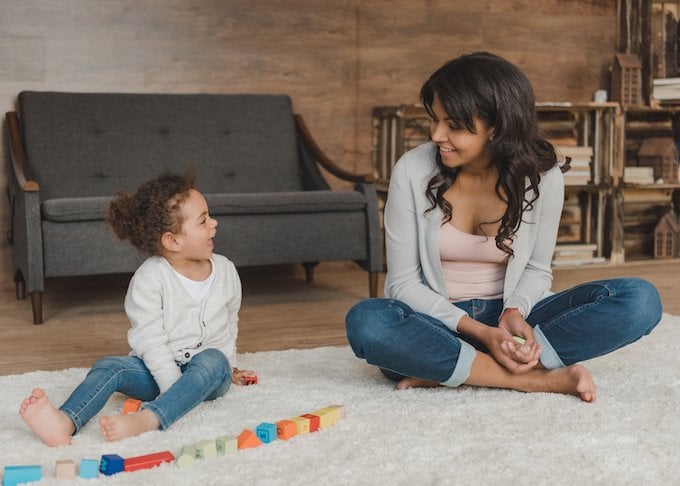Making Time-Outs Positive
Making time-outs positive is one way to bring gentle discipline into your parenting routine. We’re rethinking what the discipline term “time-out” has come to mean in modern parenting.
Time-outs have an important and effective role in gentle parenting. A time-out is a chance for both children and parents to pause, regroup, and collect themselves.
Is a Time Out Considered Gentle Parenting?
They are most effective when they are about feeling better as opposed to being used as a “sit here and think about what you’ve done” tool or a punishment for an inappropriate action.
A time out can also be a chance to regulate the nervous system for both the parent and child. When we realize how behavior changes with the feeling of a lack of safety, we can understand the critical role of the nervous system in these situations.
Taking a break and choosing regulating actions can help us support ourselves and our kids as these inevitable moments arise. This article on nervous system regulation for adults and children offers several easy ways to signal safety in the body and change the trajectory of a tantrum.
Much like those taken in sports games, time-outs teach acceptance and management of strong emotions and are a very effective discipline tool when they are used in a proactive way.
When emotions are running high, everyone needs time to calm down and feel better so that they can “improve their game.” Dr. Jane Nelsen, author of Positive Discipline: The First Three Years, advocates that children have very immature levels of brain development and need a lot of help in regulating their emotions.
“Where in the world did we get this crazy idea that in order for children to do better, first we have to make them feel worse?” says Nelsen. “Children do better when they feel better.”
She says that the way many time-outs are implemented only serve to make a child feel worse. They make a child feel ashamed, or isolated when they could be opportunities to help children learn how to handle strong emotions.
Gentle Discipline Tips for Making “Time-Out” a Positive Experience
The American Academy of Pediatrics advises that a time out should last about one minute for the age of your child. If your child is four years old, a time out of four minutes would be appropriate.
This is a good guideline, as some parents don’t realize how differently young children process time than they do. But it’s also wise to follow your child’s cues. If the break is giving them the space they need to regulate and reset, allow them to be there for as long as they need.
Here are some steps you can take to ensure that time-outs are positive and helpful experiences for your child:
1.Designate a feel-good spot.
Ask your child for input on where the two of you could create a “feel good” place for a positive time-out. It might be in their room or it might be the couch in the living room. You could also create a calm down corner at home.
To some children, going into a bedroom might seem too isolating. Some may prefer to be able to see a parent. While other children might choose their room because it can keep out younger siblings.
2.Talk about feelings.
Talk to your child about moments when they’ve been really upset at a time when no one is currently distressed. Let them know that everyone gets angry, sad, and frustrated sometimes and feeling this way is okay.
Make sure your child knows that feelings are always okay. But some emotions sure don’t feel pleasant, and it helps to know what to do then.
3. Create a comfort basket.
Find a basket and fill it with items that will help soothe your upset child during a positive time-out. Certified Positive Discipline Trainer Glenda Montgomery advocates the addition of a comfort basket in feel-good spots. “If a child has any special toy or stuffed animal that he likes to hold when he’s upset, definitely add it to the comfort basket.”
Blankets, books, and music are all excellent items to put in comfort baskets. So are lumps of clay to pound, exercise bands to stretch, and squishy balls to squeeze. Sensory activities can help small kids deal with anxiety. Older children may like to keep a journal or sketchbook in their basket, or even a bottle of bubble bath to use.
If you’re using a large area or a whole room as the feel-good spot, you could also include bigger items such as a punching bag or trampoline. The idea is to fill the area with items to help your child relieve stress and begin to calm down. Some children benefit from a physical outlet, while others prefer emotional outlets.
4. Talk with your child about what makes a time-out effective.
Ask your child if they would like to be alone or if they prefer to be around you when they’re upset.
Children have different preferences for this; some kids may feel “banished” if they are expected to go alone, and would feel more secure if you’re there supporting them, while others need to be left alone to decompress. It is important to respect their preferences and understand that these may change over the years.
Parents can ensure that positive time-outs are truly in their child’s best interest if they ask for input, work together to understand everyone’s needs, remain flexible, and keep in mind the big picture; that a time-out is just a way of helping a child feel better so they can do better.
More Gentle Discipline Resources
If the idea of a gentle parenting time out feels good for your family, you’ll probably appreciate the other gentle discipline ideas.
Positive Discipline for the Early Years
Positive Discipline for Ages 7 and Up
Supporting Your Toddler Through a Meltdown
Signs You Might Be Overparenting

